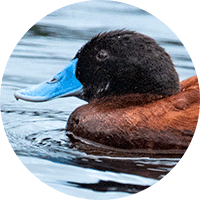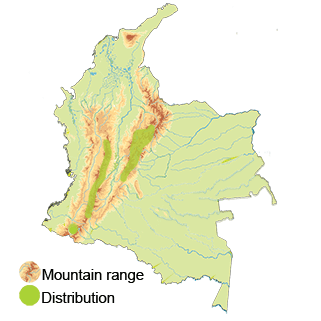Andean Duck
Appearance: The Andean Duck is a small waterfowl , with males and females exhibiting distinct sexual dimorphism. Adult males have a unique and striking plumage. They have a dark brown or blackish body with rusty-brown sides and a pale blue beak. Their eyes are bright yellow. Males also possess elongated, spatulate-shaped dark feathers on their sides during the breeding season, which are used in displays. Female Andean Ducks, on the other hand, have a more subdued appearance. They have mottled brown plumage, paler underparts, and a slimmer beak.
Size: The Andean Duck measures around 41 cm - 16 in inches in length. Males are slightly larger than females, but the difference is not significant.
Habitat: These ducks are found in high-altitude lakes, lakeshores, and other wetland habitats in the Andean region from 2400 to 4000 m.
Behavior: Andean Ducks are skilled divers and swimmers. They have the ability to propel themselves underwater using their short, strong legs and webbed feet. They feed on aquatic vegetation, small invertebrates, and insects found in their wetland habitats. They forage by diving underwater to search for food.
Breeding: During the breeding season, which occurs between September and February, male Andean Ducks engage in elaborate courtship displays to attract females. These displays involve the male raising and lowering its crest, bobbing its head, and performing a distinctive "whistle-snort" vocalization. The female constructs the nest is a shallow depression lined with plant material, close to the water's edge.
Conservation status: The Andean Duck is listed as "Least Concern" on the IUCN Red List of Threatened Species.
Distribution
The Andean Duck is most commonly observed in the highland regions of the Andes Mountains. It has been recorded in several departments, including Antioquia, Boyacá, Caldas, Cauca, Cundinamarca, Huila, Nariño, Quindío, Risaralda, Tolima, and Valle del Cauca. It prefers habitats with abundant aquatic vegetation and tends to avoid areas of dense human population.
The Andean Duck is considered a vulnerable species due to habitat loss and degradation, primarily caused by human activities such as agriculture, mining, and deforestation.
Taxonomy
- Kingdom: Animalia
- Phylum: Chordata
- Class: Aves
- Order: Anseriformes
- Family: Anatidae
- Subfamily: Oxyurinae
- Genus: Oxyura
- Species: Oxyura ferruginea
Vocalization
The vocalizations of the Andean Duck include various soft quacks, whistles, and grunts. These sounds are often used during courtship displays, interactions between mates, or as a means of communication within their social groups.
The male Andean Duck may emit low-pitched calls or soft whistles during courtship displays, which involve behavioral displays and posturing to attract a female. These vocalizations can range from gentle, melodic notes to low, monotone sounds.
Females and juveniles of the species may also produce softer quacks and grunts, especially during interactions with other individuals or during social encounters within their habitat.
It's important to note that the vocalizations of the Andean Duck are not as prominent or easily recognizable as those of other waterfowl species. They tend to rely more on visual displays and body language for communication.









